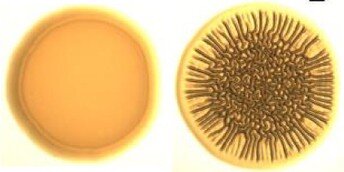Scientists have discovered an essential protein in cholera-causing bacteria that allows them to adapt to changes in temperature, according to a study published today in eLife.
The protein, BipA, is conserved across bacterial species, which suggests it could hold the key to how other types of bacteria change their biology and growth to survive at suboptimal temperatures.
Vibrio cholerae (V. cholerae) is the bacteria responsible for the severe diarrhoeal disease cholera. As with other species, V. cholerae forms biofilms—communities of bacteria enclosed in a structure made up of sugars and proteins—to protect against predators and stress conditions. V. cholerae forms these biofilms both in their aquatic environment and in the human intestine. There is evidence to suggest that biofilm formation is crucial to V. cholerae’s ability to colonize in the intestine and might enhance its infectivity.
“V. cholerae experiences a wide range of temperatures, and adapting to them is not only important for survival in the environment but also for the infection process,” explains lead author Teresa del Peso Santos, a postdoctoral researcher at the Laboratory for Molecular Infection Medicine Sweden (MIMS), Umeå University, Sweden. “We know that at 37 degrees Celsius, V. cholerae grows as rough colonies that form a biofilm. However, at lower temperatures these colonies are completely smooth. We wanted to understand how it does this.”
The researchers screened the microbes for genes known to be linked with biofilm formation. They found a marked increase in the expression of biofilm-related genes in colonies grown at 37C compared with 22C.
To find out how these biofilm genes are controlled at lower temperatures, they generated random mutations in V. cholerae and then identified which mutants developed rough instead of smooth colonies at 22C. They then isolated the colonies to determine which genes are essential for switching off biofilm genes at low temperatures.
The most common gene they found is associated with a protein called BipA. As anticipated, when they intentionally deleted BipA from V. cholerae, the resulting microbes formed rough colonies typical of biofilms rather than smooth colonies. This confirmed BipA’s role in controlling biofilm formation at lower temperatures.
To explore how BipA achieves this, the researchers compared the proteins produced by normal V. cholerae with those produced by microbes lacking BipA, at 22 and 37 degrees Celsius. They found that BipA alters the levels of more than 300 proteins in V. cholerae grown at suboptimal temperatures, increasing the levels of 250 proteins including virtually all known biofilm-related proteins. They also showed that at 37 degrees Celsius, BipA adopts a conformation that may make it more likely to be degraded. In BipA’s absence, the production of key biofilm regulatory proteins increases, leading to the expression of genes responsible for biofilm formation.
These results provide new insights into how V. cholerae adapts to temperature and will help understand—and ideally prevent—its survival in different environments and transmission into humans.
“We have shown that BipA is critical for temperature-dependent changes in the production of biofilm components and alters colony shape in some V. cholerae strains,” concludes senior author Felipe Cava, Associate Professor at the Department of Molecular Biology, and MIMS Group Leader and Wallenberg Academy Fellow, Umeå University. “Future research will address the effect of temperature- and BipA-dependent regulation on V. cholerae during host infection and the consequences for cholera transmission and outbreaks.”
Scientists provide new insights into cholera microbe and chances of pandemic strain
More information:
Teresa del Peso Santos et al, BipA exerts temperature-dependent translational control of biofilm-associated colony morphology in Vibrio cholerae, eLife (2021). DOI: 10.7554/eLife.60607
Citation:
Secret to how cholera adapts to temperature revealed (2021, February 16)
retrieved 16 February 2021
from https://phys.org/news/2021-02-secret-cholera-temperature-revealed.html
This document is subject to copyright. Apart from any fair dealing for the purpose of private study or research, no
part may be reproduced without the written permission. The content is provided for information purposes only.



